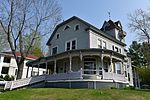Cony High School

Cony High School is a public school located in Augusta, Maine, United States that educates students from Grades 9 to 12. Cony draws its students from Augusta, as well as the surrounding communities of Chelsea, China, Jefferson, Palermo, Somerville, Vassalboro, Whitefield, and Windsor.The school's origins are in the Cony Female Academy, which was founded in 1815 by Daniel Cony, and originally opened in 1816, to provide free education to orphans and other girls under the age of 16. The school later expanded into a co-ed high school. In the fall of 2006, the city of Augusta opened a new Cony High School adjacent to the Capital Area Technical Center on Pierce Drive. Three years later, it was consolidated with local middle schools, and currently serves grades 7-12. The new building is architecturally linked to the design of the Old Cony High School building which featured a wedge-shaped flatiron design. The flatiron building has been preserved as a building of historical significance and is in the National Register of Historic Places in Maine. As of 2018–19 enrollment for Cony High is approximately 680 students.
Excerpt from the Wikipedia article Cony High School (License: CC BY-SA 3.0, Authors, Images).Cony High School
İsmet İnönü Caddesi,
Geographical coordinates (GPS) Address Nearby Places Show on map
Geographical coordinates (GPS)
| Latitude | Longitude |
|---|---|
| N 44.3135 ° | E -69.7494 ° |
Address
Sapphire
İsmet İnönü Caddesi
34415 , Emniyetevleri Mahallesi
Türkei
Open on Google Maps









